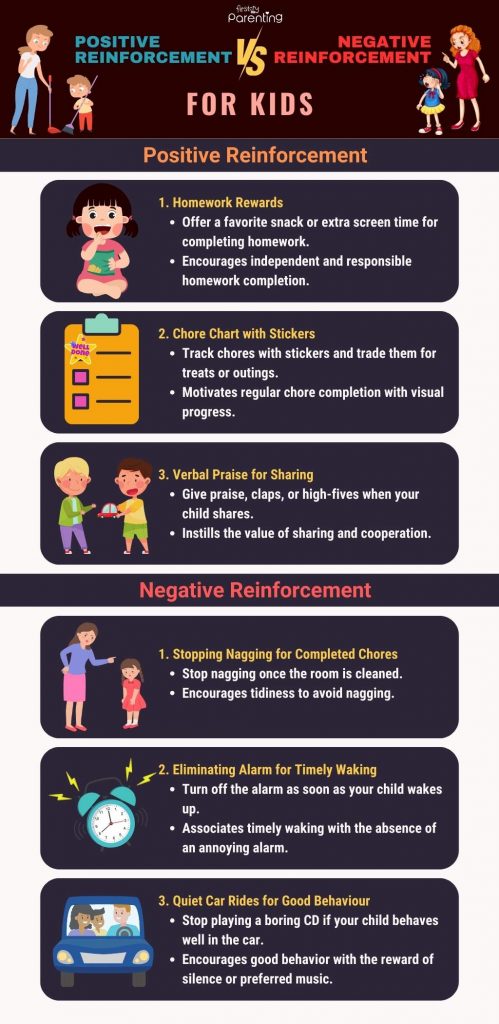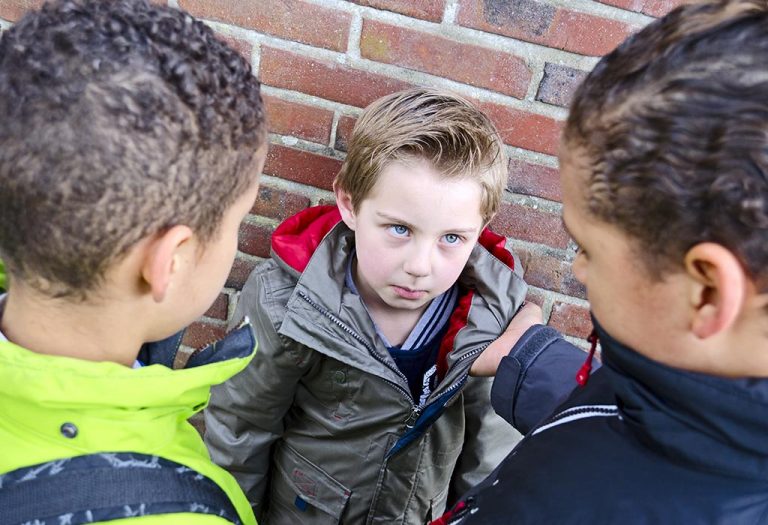Reinforcement VS Punishment – What to Choose for Dealing with Kids’ Behavioral Issues
Whether you’re dealing with temper tantrums or trying to instil a sense of responsibility in your child, you may find yourself at a crossroads. The choices you make here can significantly impact your child’s development and your relationship with them. Is it better to offer a reward, or should a certain privilege be taken away? Each path has its merits and drawbacks. You’re not alone in this problem; many parents grapple with this question daily. By diving deep into the core principles and consequences of reinforcement and punishment, we hope to provide you with valuable insights that make your parenting journey smoother.
What Is Reinforcement?
Reinforcement – Imagine a sunny day at the park. Your child sees a swing set and gleefully rushes toward it. Before you even get a chance to react, they’re swinging away, having the time of their life. After a safe landing, they return to you, eyes sparkling with joy. You smile and say, “Well done! You were so brave!”
What Is Positive And Negative Reinforcement for Kids?

Navigating the labyrinthine world of parenting, you’ve probably heard the terms “positive reinforcement” and “negative reinforcement” thrown around quite a bit. But what do these terms truly mean, especially when applied to children? Let’s demystify these buzzwords and dive into what positive and negative reinforcement means in the context of your child’s behavioural development.
Positive Reinforcement
Positive reinforcement is all about adding something pleasurable or rewarding to encourage the repetition of a specific behaviour. In simpler terms, when your child does something good, you offer a valuable reward, making it more likely that they’ll repeat that good behaviour (1).
Negative Reinforcement
Conversely, negative reinforcement involves removing an unpleasant stimulus to encourage positive behaviour. This might sound confusing, but negative reinforcement is different from punishment. The focus here is on promoting good behaviour by removing something uncomfortable or undesirable when that good behaviour occurs (2).
What Are Some Examples of Positive And Negative Reinforcement for Kids?

Understanding the theory behind positive and negative reinforcement is essential, but sometimes, we all need concrete examples to paint a clearer picture. This section will offer some practical, real-world scenarios where these reinforcement techniques can be applied so you can visualize how they might work in your parenting journey.
Examples of Positive Reinforcement
1. Homework Rewards: You might offer a small reward, such as a favourite snack or an extra 15 minutes of screen time, each day that homework is completed without fuss. This encourages not just doing homework but also doing it independently and responsibly.
2. Chore Chart with Stickers: Create a chart that tracks household chores, and let your child place a colourful sticker next to each completed task. After collecting a certain number of stickers, they can be traded in for a special treat or outing.
3. Verbal Praise for Sharing: If you catch your child sharing toys or snacks with a sibling or friend, lavish them with verbal praise, claps, or even a high-five. This immediate positive reinforcement can instil the importance and value of sharing early on.
Examples of Negative Reinforcement
1. Stopping Nagging for Completed Chores: If you constantly nag your child to clean their room, stop nagging as soon as the task is done. The absence of your nagging serves as negative reinforcement, encouraging your child to keep their room tidy to avoid future nagging.
2. Eliminating Alarm for Timely Waking: If an annoying alarm is set to go off every morning until your child gets out of bed, make it a point to turn it off as soon as it arises. They’ll quickly associate waking up on time with the pleasant absence of the annoying alarm sound.
3. Quiet Car Rides for Good Behaviour: If your child is well-behaved during car rides, you could stop playing that educational CD they find boring. The silence or their choice of music becomes the reward, encouraging future good behaviour in the car.
What Is Punishment?
So far, we’ve delved deep into the constructive world of reinforcement, focusing on ways to encourage good behaviour. But what about the flip side of the coin—punishment? Many consider it the “necessary evil” of parenting, used to deter undesirable behaviour. But what does it entail, and when should it be applied? Let’s take a closer look at punishment and its role in child-rearing.
What Constitutes Punishment?
Punishment is essentially the introduction of an unpleasant stimulus or removing a pleasant one to decrease the likelihood of a behaviour being repeated. Unlike reinforcement, which aims to encourage a behaviour, punishment seeks to suppress or eliminate undesirable actions or attitudes (3).
What Is Positive And Negative Punishment for Kids?
Now that we’ve peeled back the layers of punishment as a general concept let’s hone in on its two main types: positive punishment vs negative punishment. These phrases might sound contradictory, but they are pivotal in children’s behavioural management. Understanding the distinction between the two can help parents create a more nuanced approach to discipline.
Positive Punishment
Positive punishment or disciplining is adding an unpleasant stimulus to decrease or stop unwanted behaviour. The term “positive” here doesn’t refer to something good; instead, it means that something is being added to the situation. For example, a scolding or adding chores would fall under this category (3).
Negative Punishment
Negative punishment, on the other hand, entails taking away something enjoyable or beneficial to reduce or eliminate undesired behaviour. In this case, “negative” refers to removing something from the environment, like taking away a favourite toy or cancelling a much-awaited trip to the amusement park (3).
What Are Some Examples of Positive And Negative Punishment?
Theories and definitions are good starting points, but sometimes, real-world examples bring these concepts home. In this section, we’ll explore some practical examples of both positive and negative punishment to help you pinpoint when and how to use these tactics effectively in your parenting journey.
Examples of Positive Punishment
1. Immediate Scolding: If your child is caught doing something dangerous, like touching a hot stove, an immediate and stern “No!” is a positive punishment designed to stop the action instantly.
2. Extra Chores: If your child neglects their regular chores, assigning them additional duties like cleaning the garage can be a positive punishment.
3. Timeouts: A positive punishment can be placing a child in a designated timeout area immediately following an undesirable action like hitting a sibling.
Examples of Negative Punishment
1. Loss of Screen Time: If your child refuses to do their homework, taking away an hour of screen time serves as negative punishment, emphasizing the loss of something enjoyable due to poor choices.
2. Canceling Playdates: If your child is continuously mean to their siblings, cancelling an upcoming playdate can be a negative punishment.
3. Taking Away a Favourite Toy: If your child refuses to clean up their toys, temporarily taking away a favourite item can help them understand the importance of responsibility.
Reinforcement Versus Punishment For Kids
Deciding between reinforcement and punishment is a crucial aspect of effective parenting, and understanding the difference can make all the difference in your approach. While reinforcement aims to increase the likelihood of a desired behaviour through rewards or removing unpleasant stimuli, punishment seeks to diminish undesirable behaviours by introducing an unpleasant experience or taking away something enjoyable. This section aims to help you strike a balance between the two, equipping you with the knowledge to build a harmonious and well-disciplined home environment (4).
Positive Reinforcement vs. Negative Reinforcement
There are two primary types of reinforcement: positive and negative. While both aim to encourage the desired behaviour, they do so through different mechanisms. Understanding the differences between these two types is key to making the most of reinforcement techniques.
| Positive Reinforcement | Negative Reinforcement | |
| Objective | To add something pleasant or rewarding to increase the likelihood of a behaviour. | Removing something unpleasant increases the likelihood of a behaviour. |
| Example | Giving a child a sticker for completing homework. | Turning off an annoying alarm when the child wakes up for school on time. |
| Emotional Impact | It often creates a positive emotional connection and can be more enjoyable for the child. | It can relieve stress or discomfort but might not build as strong an emotional bond as favourable reinforcement. |
| Common Use Cases | Rewarding good grades, completing chores, or practising manners. | Stopping nagging when a chore is done, ending a timeout when calm behaviour is displayed. |
| Effectiveness | Generally effective for teaching new behaviours and skills. | Typically effective for encouraging persistence in existing behaviours. |
Positive and negative reinforcement can effectively shape behaviour, but each has unique advantages and ideal use cases. Understanding these nuances can help you deploy the most effective strategies for your child’s needs.
Positive Versus Negative Punishment
The terms ‘positive’ and ‘negative’ might sound a bit confusing when it comes to punishment. However, just like in reinforcement, these terms are essential for understanding how to curtail kids’ undesired behaviour effectively. Below, we summarise positive and negative punishment characteristics to provide a clearer picture.
| Positive Punishment | Negative Punishment | |
| Objective | To add an unpleasant stimulus to decrease a behaviour. | To remove a pleasant stimulus to decrease a behaviour. |
| Example | Assigning extra chores when a child neglects their regular ones. | Taking away a favourite toy when a child misbehaves. |
| Emotional Impact | It can sometimes lead to resentment or emotional distance if not used carefully. | It also risks causing emotional distress but may be perceived as more ‘fair’. |
| Common Use Cases | Immediate cessation of dangerous or highly disruptive behaviour. | For teaching lessons about the consequences of actions over the longer term. |
| Effectiveness | It is often effective for immediate behaviour change but may lack long-term effectiveness. | Generally, it provides a more lasting lesson about the consequences of actions but may take time to show effects. |
Understanding the distinctions between positive and negative punishment allows you to use each more effectively and in the appropriate contexts. Like reinforcement methods, these punishments can be powerful tools when used wisely and in balance with each other.
Parenting is a complex yet rewarding journey that often involves navigating the murky waters of behavioural management. Understanding the nuanced differences between reinforcement and punishment and their positive and negative variants can help parents effectively guide their children towards better behaviour. So, what is the difference between reinforcement and punishment? Simply put, reinforcement aims to encourage desirable behaviour, while punishment intends to discourage undesirable actions. Regarding positive and negative punishment, the former adds an unpleasant stimulus to deter bad behaviour, while the latter takes away something enjoyable.
Furthermore, grasping the difference between negative reinforcement and punishment is essential. Negative reinforcement removes an unpleasant experience to encourage good behaviour, whereas punishment, in either its positive or negative form, seeks to diminish undesirable behaviours.
It’s all about balance and context. Understanding these terms and how they fit into your parenting style can offer you a broad set of tools to use as you shape your child’s behaviour and overall character. May your parenting journey be as informed and loving as you strive for a well-behaved, happy, and emotionally secure child.
References/Resources:
1. Nickerson, C.; Positive Reinforcement: What Is It And How Does It Work?; Simply Psychology; https://www.simplypsychology.org/positive-reinforcement.html
2. Nickerson, C.; What is Negative Reinforcement?; Simply Psychology; https://www.simplypsychology.org/negative-reinforcement.html
3. Morin, A.; The difference between discipline and punishment; Understood; https://www.understood.org/en/articles/the-difference-between-discipline-and-punishment
Also Read:
Behaviour Modification Techniques for Children
Negative Discipline Techniques Parents Should Not Use
Was This Article Helpful?
Parenting is a huge responsibility, for you as a caregiver, but also for us as a parenting content platform. We understand that and take our responsibility of creating credible content seriously. FirstCry Parenting articles are written and published only after extensive research using factually sound references to deliver quality content that is accurate, validated by experts, and completely reliable. To understand how we go about creating content that is credible, read our editorial policy here.






















